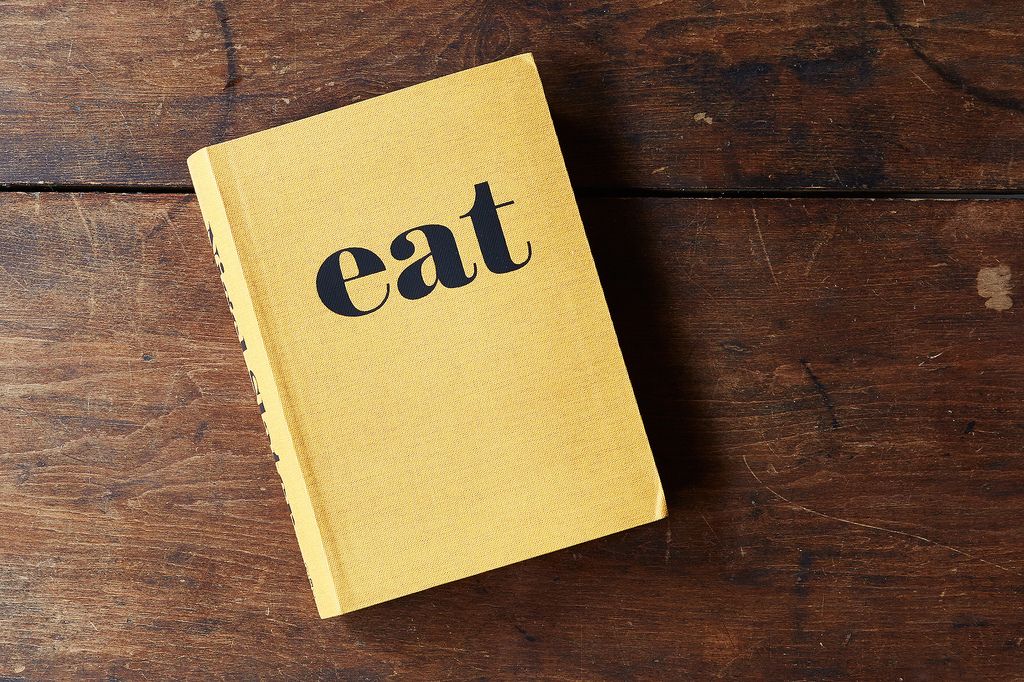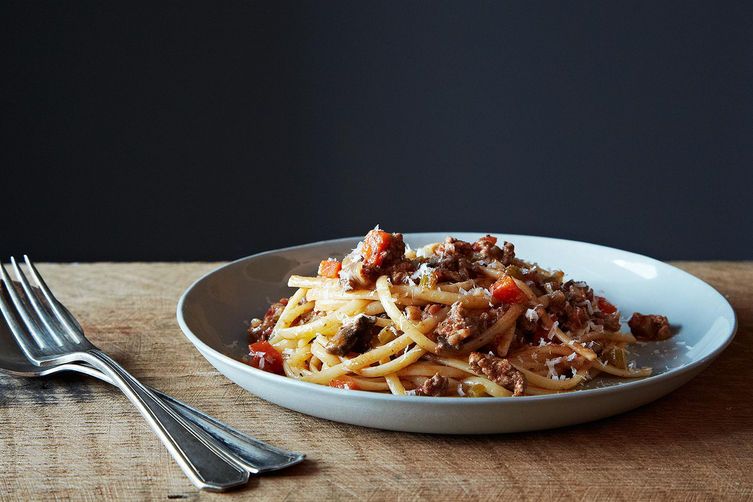Read up on some of 2014’s most-loved cookbooks, tested and reviewed by the one and only Food52 community.
Today: Cristinasciarra explains why she's dazzled by Piglet-alumnus Nigel Slater's Eat.

From the start, Eat separates itself from the pack: The cover doesn’t tease edible pin-ups or moody ceramic bowls. Instead, its jacket is uniformly canary yellow, “eat” printed plainly across it in lowercase block letters. It's a bold cover -- almost a throwback -- and unusual in a pile of contemporary cookery books. But if Eat's shell is a reminder of the past, this is where it stops.
The book is practical; it means to get dinner on the table without fuss or ceremony. Its frame is small enough to slip into a work bag to read on the subway, and recipes are paired with one modest finished dish photo. Jonathan Lovekin’s photography is sumptuous as ever, but these snapshots are more visual aid than food siren. Slater writes,
Sometimes we cook purely for the pleasure of it, understanding the provenance of our ingredients, choosing them with great care...But sometimes, we just want to eat. This book is for those times. The days we have barely an hour...The times we want something delicious...at the end of our working day.

The book lassos many cuisine styles and cooking methods (sections are divided into categories like “little stews,” “in a wok,” and “in the hand”). The collection is unified by simplicity, but more so, recipes are bound by Slater’s talent for constructing dishes that become more than the sum of their parts. His Mozzarella Chorizo Sandwich totals four ingredients: Applying low heat to the chorizo and mozzarella yields a hot, spiced, creamy mess of a sandwich, drenched with as much chorizo-mozzarella oil as you can bear, returned to earth by the addition of half-wilted spinach. I was shocked by the zippy depth that his Ten Minute-Pickled Cucumbers brought to a bresaola, Emmentaler, and pickled cucumber sandwich. This is Slater’s gift: creating new flavor combinations from everyday ingredients. A bagel comes slathered with mascarpone, balsamic vinegar, and golden raisins. A strawberry and cucumber salad relaxes in a puddle of honey, mint, and elderflower syrup.
More: Have you tried Nigel Slater's Really Good Spaghetti Bolognese? You should.
Slater's recipes are always open sources of inspiration, but in Eat, instruction becomes looser than ever. A breakfast bagel calls not for cheddar, but an "interesting cheese." Procedure is styled after the shorthand notes of a seasoned cook. In this way, Eat might not be ideal for a novice: "Slice eggplant, tomatoes, and zucchini, toss them in plenty of olive oil, then season with lots of garlic, black pepper, salt, and finely chopped rosemary. Roast til everything is very soft." While uncomplicated, Eat relies upon an intuitive knowledge of cooking -- what it means to salt to taste, and how to quantify "lots of garlic."

More: Watch Slater's Notes from the Larder face off with The Art of Fermentation in last year's Piglet competition.
But Slater goes further than seasoned cook-shorthand. A Vietnamese shrimp baguette is “one of the great sandwiches, IMHO (in my humble opinion).” Twitter even gets mention in the introduction, as he explains the cookbook's style: "The form...is new," Slater says, "Written in the style of an extended tweet, they are no dogged '1-2-3' sets of instructions."
He embraces the way we communicate now. From another author, this style might seem like a short cut. Not from Slater. Recipes are pithy, but also clear, well-formatted, and free of clutter. He makes room for lush prose: "A simple miso broth for a fragile moment"; "the ancient scent of za'atar and olives." Monkfish with Pancetta and Clams promises "pan juices that dazzle"; sausage danishes are "viennoiserie for carnivores." And my favorite: "Roasted vegetables, garlic mayo. The warm, sweet breeze of basil." The warm, sweet breeze of basil!
His professionalism remains in full display, as well; it is full of masterful, soon-to-be classic recipes, prose, and knowledge. He notes that monkfish isn't currently sustainable, and what to substitute instead. And he's specific when he needs to be -- about which pork ribs to buy and why, and where to find pomegranate molasses.
Eat’s tagline is, “the little book of fast food.” It's funny, considering the 413-page length -- and not one recipe exceeding one page. I’ve bookmarked the Herb Ricotta Cakes and Quick Pork Ribs with Honey and Pomegranate Molasses. My copy is now a bright flurry of “to make!” and “to make again!” Post-Its. I can't think of higher cookbook praise than that.
First photo by Mark Weinberg; all others by James Ransom





See what other Food52 readers are saying.